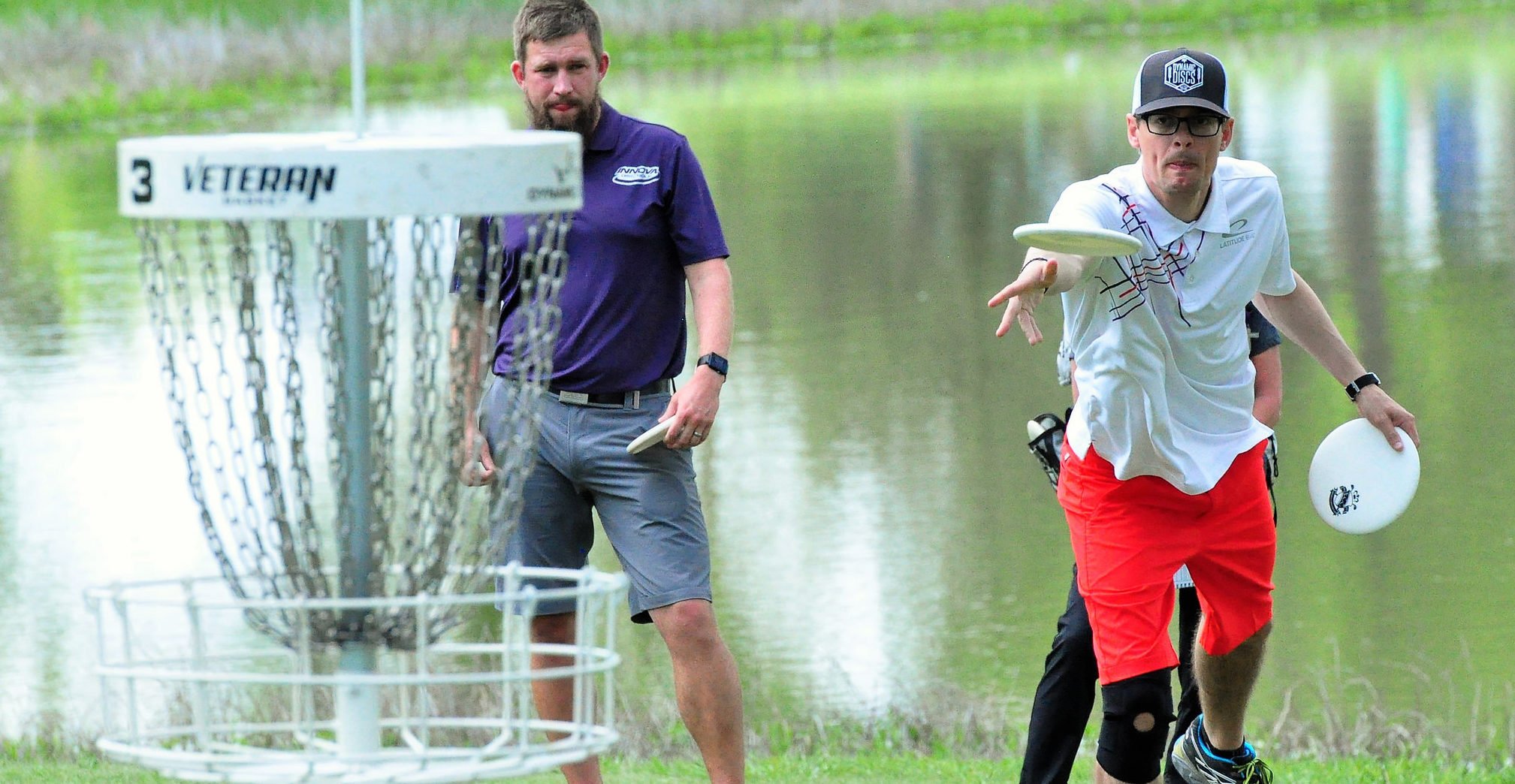Disc Golf
Disc Golf is a variant of ball golf, but with special frisbees or flying discs. However, instead of hitting a ball off a tee and aiming at getting it down a hole in as few strokes as possible, disc golf involves throwing a disc from the tee and hitting an above-ground target in as few throws as you can. Disc golf courses are considerably shorter than ball golf courses, although a disc golf course will tend to cover much more undulating terrain and make more use of natural obstacles along the fairway.
Disc Golf is a sport based on equality and inclusion. WFDF values all people equally and endeavours to make a significant difference to the way we relate to each other. Issues such as Climate Change and Sustainability, Development and Inclusion are at the heart of all disc sports and an important part of Disc Golf. Though the main focus for many disc golfers is the competitive element of play, WFDF is committed to participation, engagement and the opportunity to sustain a healthy lifestyle far more than focus on elite competitive play. It is about making disc sports accessible to communities world-wide irrespective of gender, ability, social class or any other factor.
The sport is cheap to play and accessible to anyone - even if there isn’t an established course nearby players can make up object courses or use temporary baskets to create holes and courses of their own. The sport can be played by all ages and all abilities and though it is essentially you against the course there are also team events and competitions. All variations of Disc Golf bring the values of Spirit of the Game to the fore. It is self-officiating and marshalled by all who play with a code of conduct that requires the highest standards of honesty and integrity as well as self-reliance and self-regulation of behaviour. Like all disc sports, Disc Golf helps develop personal strengths that enable individuals to be resilient, reliable and resourceful.
A Brief History of Disc Golf
Though there are many claims to the first disc golf course and the game being played, including Persian, Greek and Roman versions, the first organised modern age disc golf sports date back to the 1960’s, and the first course was opened in 1975 in California, USA. Since then the sport has gone from strength to strength, with over 2000 registered courses, and an estimated 500,000 regular players, although there are far more unlisted courses and casual players across the globe. Currently Disc Golf is available to play in all WFDF member nations with official administration in over 45 countries.
There are many books, films and social media postings available for people to explore the depth and range, history and practice of the Disc Golf experience, from elite play to recreational fun. Youtube is a good place to start!
Rules
A comprehensive set of rules has been developed over the years by the Professional Disc Golf Association (PDGA) so that there can be a consistency of play at events.
https://www.pdga.com/rules/official-rules-disc-golf
The PDGA is the organisation established for individual players worldwide. It provides the Rules of play, Competition Manuals, Course Directory and individual player Ratings as well as many other facilities. WFDF works closely with PDGA to ensure that its respective members are well served and represented.
Equipment
The science behind the sport has evolved considerably since the creation of the first plastic frisbee over 60 years ago. The discs which are being thrown in today are aerodynamically engineered and produced in high-tech plastics to perform consistently and reliably throw after throw. There are many manufacturers of discs to play Disc Golf as well as makers of disc golf targets, all of which are required to be approved for competitive use.
About the Discs Used in Disc Golf
Whereas traditional golfers carry a bag full of clubs for hitting the ball with, disc golfers will carry a selection of discs that can be thrown in a variety of ways to achieve the necessary ‘shape’ and distance of shot to avoid obstacles and get close to the target.
Time for some terminology then. The phrases below refer to a right handed backhand throw. For left handed shots, simply reverse the direction:
Understable : tendency to turn to the right
Stable : will hold a straight line
Overstable : these discs will turn to the left
The discs will have different flight characteristics when thrown, some turn right, others turn left, some turn right then left, some even fly straight! All these characteristics are related to the ‘stability’ of the disc, which in turn depends on a wide range of factors : weight, shape, type of plastic, air speed, spin, angle of release. Most discs have product descriptions that tell you the flight characteristics for that disc, so you can choose a disc that suits your style.
Technical standards
The following links list approved Disc Golf Discs and Disc Golf Targets:
https://www.pdga.com/technical-standards/equipment-certification/discs
https://www.pdga.com/technical-standards/equipment-certification/targets
Thanks to the PDGA for linking WFDF to their pages.
Taking Care of yourself and others
Care needs to be taken when playing in public areas. People may not realise what you are doing. Play sensibly and play safe, respect the environment and don’t be surprised if people ask you what you’re up to! If you’ve got a spare disc or two, give them a go!

The tee and the target
A disc golf course is typically composed of 9 or 18 holes. On each hole players attempt to reach a target, starting at the tee. Distances vary be- tween 60 and 150 meters. Almost anything can serve as a goal: a tree, a lamppost or a dustbin. In official tournaments disc trapping targets are used. A target is a round metal basket on a pole. Above the basket some loose chains are attached. These stop the disc in its flight and make it fall down into the basket. The target is then reached only when the disc falls into the basket.
Out-of-bounds
Every hole has specified boundaries. These are mostly natural and follow the landscape, like a road, a flower-bed or a lake. When your disc lands outside the playing field it is out-of-bounds. Players get a penalty of one throw and can continue at the position where the disc left the playing field. If the disc falls into water, the next throw is taken from the bank at the point where it left the playing field.
The Tee
The tee is the throwing area to begin play and is usually an area marked with a throwing line. At the first hole it is decided in which order the players throw by the names on the scorecard. After that the result of the preceding hole de- termines the order: the best score throws first, and so on.
The fairway
After the first throw from the tee the player whose disc is the farthest from the target, throws again first. The next throw is played from the position where the previous throw came to rest. Before picking up the disc the player (or caddy!) places a marker-disc (a mini disc of about ten centimetres) in front of the thrown disc. At the next throw the player’s front foot must be on the ground within thirty centimetres behind the marker-disc.
A disc which doesn’t land on the ground
Play must continue from the position where the disc lies on the ground. However it can occur that the disc is not on the ground if, for example, it remained in the branches of a tree. In this case, if the disc is less than two meters from the ground, play can continue from the position right below the disc. However when the disc is more than two meters from the ground, there is a penalty of one throw. The players then positions the disc directly below where it came to rest and continues playing according to the out-of-bounds rule (see above).
Different discs for different situations
Disc golf players will find themselves in many different situations, each requiring a different approach. In some cases a long distance must be covered, at other times the disc must be thrown with a large curve around a tree. Where a ball golf player can choose from several clubs, a disc golf player may choose from several discs, each with specific flight or "rolling" proper- ties. For each throw players may pick the disc that seems to be appropriate.
Of course you can play disc golf with an “ordinary” disc. However you’ll notice that the special disc golf discs are more suitable for this sport. For instance you can easier cover a long distance with a "driver" or putt with a "putter". For approaches from 40-60 meters you can use an "ap- proach disc". Remember that these special disc golf discs are not made for catching. You can injure yourself when you try! So be careful. Also as a player, make sure there is no possibility to injure another person be- fore you throw.
As in the other disc sports, the players themselves are responsible for the course of the game. This sheet provides the most important rules only. This is enough to get started. Of course, when you want to participate in official competitions, it is wise to become familiar with all the rules. Your national as- sociation can provide you with these. Or you can download them from the WFDF website. In addition, the more experienced players at a tournament are often willing to give an explanation when needed.
You can contact your national or local association for more information on courses and competitions. Perhaps there is a Disc Golf course in your neighbourhood!
When there is no disc golf course available you can set up your own practice course easily. In a public park you’ll find more than enough things which can serve as targets: trees, lampposts, benches, dustbins. If need be you can use one target for a number of holes by setting up a number of tees with a mandatory route for the disc. For instance, the disc must pass a tree to the right-hand side. Start with small distances, where you can throw directly at the target. Later you can expand the distances and add “mandatory” trees or bushes. Eventually you can organise your own local disc golf event.
Where Can You Play Disc Golf in the World?
There are 45 countries that currently have established Disc Golf Associations (DGA’s) and a registered membership. They are either members of WFDF or affiliated to the PDGA. There are many other countries with Disc Golf courses who are not as advanced in their organisation but where it is possible to still find a course and play the sport.
If you want to find the established courses, there is a list on the PDGA web site.
https://www.pdga.com/course-directory
Most of these courses will be free to play but some are commercial ventures and may require booking in advance. Get in touch with your national DGA for more detailed information on courses and players as well as learning to how to play the game and maybe even join your local club. By joining clubs and your national association you can support the values of disc sports world-wide and demonstrate your commitment to the values that WFDF hold dear.








